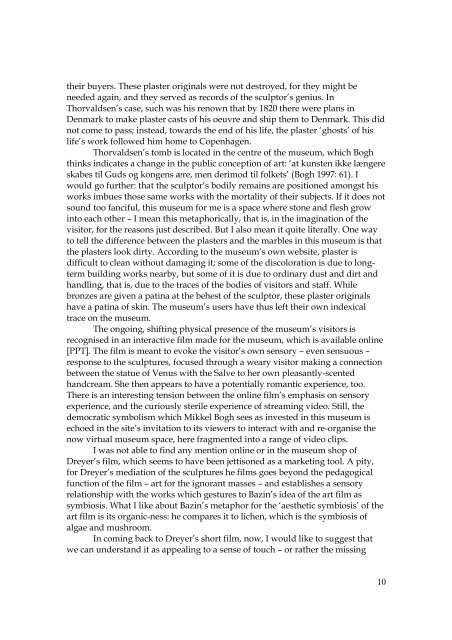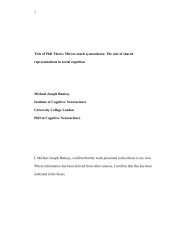A Cinema of Dust: On the Ontology of the Image from Dreyer's ...
A Cinema of Dust: On the Ontology of the Image from Dreyer's ...
A Cinema of Dust: On the Ontology of the Image from Dreyer's ...
Create successful ePaper yourself
Turn your PDF publications into a flip-book with our unique Google optimized e-Paper software.
<strong>the</strong>ir buyers. These plaster originals were not destroyed, for <strong>the</strong>y might be<br />
needed again, and <strong>the</strong>y served as records <strong>of</strong> <strong>the</strong> sculptor’s genius. In<br />
Thorvaldsen’s case, such was his renown that by 1820 <strong>the</strong>re were plans in<br />
Denmark to make plaster casts <strong>of</strong> his oeuvre and ship <strong>the</strong>m to Denmark. This did<br />
not come to pass; instead, towards <strong>the</strong> end <strong>of</strong> his life, <strong>the</strong> plaster ‘ghosts’ <strong>of</strong> his<br />
life’s work followed him home to Copenhagen.<br />
Thorvaldsen’s tomb is located in <strong>the</strong> centre <strong>of</strong> <strong>the</strong> museum, which Bogh<br />
thinks indicates a change in <strong>the</strong> public conception <strong>of</strong> art: ‘at kunsten ikke længere<br />
skabes til Guds og kongens ære, men derimod til folkets’ (Bogh 1997: 61). I<br />
would go fur<strong>the</strong>r: that <strong>the</strong> sculptor’s bodily remains are positioned amongst his<br />
works imbues those same works with <strong>the</strong> mortality <strong>of</strong> <strong>the</strong>ir subjects. If it does not<br />
sound too fanciful, this museum for me is a space where stone and flesh grow<br />
into each o<strong>the</strong>r – I mean this metaphorically, that is, in <strong>the</strong> imagination <strong>of</strong> <strong>the</strong><br />
visitor, for <strong>the</strong> reasons just described. But I also mean it quite literally. <strong>On</strong>e way<br />
to tell <strong>the</strong> difference between <strong>the</strong> plasters and <strong>the</strong> marbles in this museum is that<br />
<strong>the</strong> plasters look dirty. According to <strong>the</strong> museum’s own website, plaster is<br />
difficult to clean without damaging it; some <strong>of</strong> <strong>the</strong> discoloration is due to longterm<br />
building works nearby, but some <strong>of</strong> it is due to ordinary dust and dirt and<br />
handling, that is, due to <strong>the</strong> traces <strong>of</strong> <strong>the</strong> bodies <strong>of</strong> visitors and staff. While<br />
bronzes are given a patina at <strong>the</strong> behest <strong>of</strong> <strong>the</strong> sculptor, <strong>the</strong>se plaster originals<br />
have a patina <strong>of</strong> skin. The museum’s users have thus left <strong>the</strong>ir own indexical<br />
trace on <strong>the</strong> museum.<br />
The ongoing, shifting physical presence <strong>of</strong> <strong>the</strong> museum’s visitors is<br />
recognised in an interactive film made for <strong>the</strong> museum, which is available online<br />
[PPT]. The film is meant to evoke <strong>the</strong> visitor’s own sensory – even sensuous –<br />
response to <strong>the</strong> sculptures, focused through a weary visitor making a connection<br />
between <strong>the</strong> statue <strong>of</strong> Venus with <strong>the</strong> Salve to her own pleasantly-scented<br />
handcream. She <strong>the</strong>n appears to have a potentially romantic experience, too.<br />
There is an interesting tension between <strong>the</strong> online film’s emphasis on sensory<br />
experience, and <strong>the</strong> curiously sterile experience <strong>of</strong> streaming video. Still, <strong>the</strong><br />
democratic symbolism which Mikkel Bogh sees as invested in this museum is<br />
echoed in <strong>the</strong> site’s invitation to its viewers to interact with and re-organise <strong>the</strong><br />
now virtual museum space, here fragmented into a range <strong>of</strong> video clips.<br />
I was not able to find any mention online or in <strong>the</strong> museum shop <strong>of</strong><br />
Dreyer’s film, which seems to have been jettisoned as a marketing tool. A pity,<br />
for Dreyer’s mediation <strong>of</strong> <strong>the</strong> sculptures he films goes beyond <strong>the</strong> pedagogical<br />
function <strong>of</strong> <strong>the</strong> film – art for <strong>the</strong> ignorant masses – and establishes a sensory<br />
relationship with <strong>the</strong> works which gestures to Bazin’s idea <strong>of</strong> <strong>the</strong> art film as<br />
symbiosis. What I like about Bazin’s metaphor for <strong>the</strong> ‘aes<strong>the</strong>tic symbiosis’ <strong>of</strong> <strong>the</strong><br />
art film is its organic-ness: he compares it to lichen, which is <strong>the</strong> symbiosis <strong>of</strong><br />
algae and mushroom.<br />
In coming back to Dreyer’s short film, now, I would like to suggest that<br />
we can understand it as appealing to a sense <strong>of</strong> touch – or ra<strong>the</strong>r <strong>the</strong> missing<br />
10
















